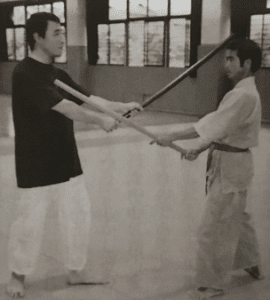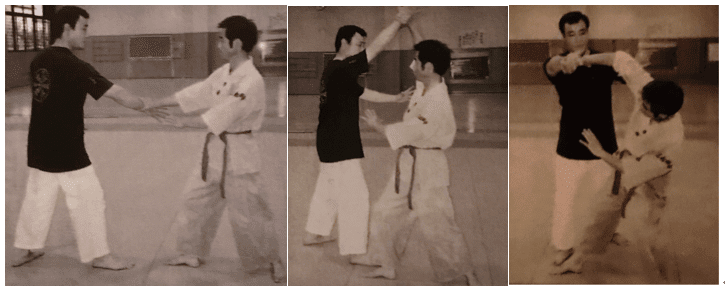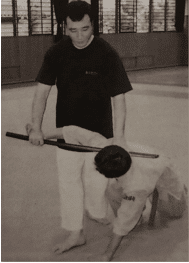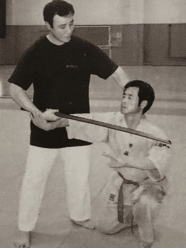Theory of Aikido’s Four Lesson (四教論) :True Meaning of Aikido Technique Ikkyo to Yonkyo
when I met the bujitsu(Japanese martial arts) ordinary called “Aiki bujitsu”(general term of Aikido and Daitoryu aiki jujitsu) I was 30 years old. I bought the vedio of Daitoryu aiki jujitsu from book store.

The world of “Aiki” was completely unknown for me. It seems very different from Karate which I used to practice. I couldn’t find out it was just a fake or not.
Then I search the information about Aiki bujitsu and finally I decided it was not just a fake. So I tried to experience the Aiki bujitsu and I chose the Kansai Aikikai dojo.
However, just because I went to a dojo does not mean I will see things like masters techniques from the beginning. First I started basic practice with other young and old.
I have always been interested in the world of religion and philosophy. In particular, I was vaguely thinking that the philosophy of the Old Shinto would create a new world. I was feeling like Shinto’s idea can change the “Terminal current situation”. It was such a time when I met the Morihei Ueshiba Aikido philosophy.
The joy of meeting exactly what I was looking for has led me to further practice and research.
However, even with the increase in brain-level knowledge, it was not possible to say that it could actually be understood by the body. In order to do more practice I left the company I was working in and started the free work of time. And one day, something suddenly opened up.
Feel the law of Aikido by my skin
After the opening up I became able to understand the philosophy of founder one after another which I used be thought difficult before.
I have a feeling that all the Aikido techniques are based on one law and it doesn’t need physical strength as I thought before.
law stands from two “Qi(ki)” of the yin and yang which create the universe. There is Yin and Yang inside of Yin. There is Yin and Yang inside of Yang.

unite and circulate of these four basic elements create every events in the universe.
This is “Qi Ryu Go Zyu (Energy, Flowing, Willow, Diamond)” and “Ten Ka Sui Chi (Heaven, Fire, Earth, Water)” it is same meaning as “Chi Yuu Sin Ai (Wisdom, Brave, Kind, Love)” that founder said.
Harmony of four things will be realizing the work of “Sei-sei-ka-iku”.

means make life and grow.
The positive side represents creation and development.
the negative side represents decline and destruction.
Life and death are one. creation and destruction are one.
It called “愛 (Ai)” which means the heart of universe.
We should stand on center of these four Yin and Yang and unite it. This is what the founder often said that we should stands on floating bridge. This is the way of life united with heart of universe. I’m thinking that Aikido is the way of discipline to be like this.
Therefore Aikido must be done by following to circulation of universe and 生成化育(law of life and death).
(I’m think this is the “Kokyu (breath)” in Aikido)
At first I was not sure about sudden awareness of understanding Aikido law. So I tried various experiments and proceeded while verifying the theory one by one. Now I’m convinced that there was no mistake in my direction.
At the same time I decided to leave the city where I live. I also decided to leave from dojo and I wanted to research Aikido more freely and more deeper.
I moved to Yoshino in Nara Prefecture four years ago and I spent the days of Aikido research while doing mountain work.
I started a study group last year with local people, friends, and practice peers and started teaching my own Aikido. To the present while carrying out further arrangement of the theory.
What we have to teach
As to be a person teaching Aikido, I have visited various dojos and have met various Sihan (Teacher).I have also studied many technical guide book.
However, I have always felt that most of the trainees have hardly transmitted the true Aikido. I think that is because they are teaching about Kata too much and teaching of essential techniques are too late.
Every each dojo will be teaching mainly on basic skills. But even the basic skills are different depending on each dojos Sihan (Teacher). Some dojo focus on teaching the tradition Kata. Some dojo focus on teaching flowing movement than the tradition Kata. Some focus on strong movement. Some focus on soft movement. Sometimes there are multiple teachers in the dojo and they teach different way.
What is the “Kata” in Aikido?
“Aikido must follow to the Kata and break the kata and create the kata by yourself” It is a word of Aikido founder Morihei Ueshiba. I understand that Kata Keiko (practice) is not only mimics the apparent form, but also researching the logic that flows in Kata. There is no point in remembering the Kata as long as you do not understand the logic.
As the Japanese saying “beginning is heart of things” it can say in everything. Many learners may lost the way because teachers don’t teach the meaning of Kata and the “essence” of Aikido at the first stage.
Realization of a lifestyle called Aikido
Generally, the theory of Aikido is considered to be difficult. But I have always said that up to a certain level, Aikido is easy if you understand the theory.
It is natural to think difficult without learning the theory and it’s also wasteful for you. Using words such as Qi(ki), Ai (Love), and wagou (union, harmony) makes it even more confusing and mysterious.
First of all, you should learn in the form of visible, felt and physically common sense. You must understand that in your mind. Otherwise, no matter how much practice is done there is no effect.
Because of the teachers himself says that it is difficult or they try to teach things that they didn’t understand it, “misunderstanding” continues forever.
At first think easy way and start from easy level. That is the correct order of education, and it is the duty of the teachers to do so.
Meanings of “kyo (教)” which used on Ikkyo (一教) and Nikkyo (二教)
I would like to introduce some of my research on Aikido, at first I want you to understand that this is only my own private opinion.
Aikido techniques are infinite. Although the names of some basic techniques are widely known, there are many things that have no name in free style techniques.
Such techniques are only applications of Ikkyo to Yonkyo. Kisshomaru Ueshiba wrote that “Aikido is enough from Ikkyo to Yonkyo.” Also founder Morihei was told, “Ikkyo to Sankyo is a preparatory exercise, after that Aikido starts.”
Considering these things together, the Ikkyo to Yonkyo are not just only the technique usually known. In the general description Ikkyo “hold arms”, Nikkyo “turn kote”, Sankyo “twist kote”, Yonkyo “hold wrist”.
These are just for convenience for teaching kata to beginners. All you have to do is to learn the true lesson (Japanese 教 Kyo stands for lesson) from each kata.

In other words, it is my idea that Ikkyo to Yonkyo are not just names of techniques, but as you read it is “the lesson of 1 to 4”. (theory of four lesson)
Annotation
In Japan we count number as Ichi (one), Ni (two), San (three), Yon (four).So Ikkyo to Yonkyo can be say as Lesson one to four.
Introduction of four lesson (Yon-kyo-Ron)
Before I found out the theory of four lesson. At first I thought that Ikkyo and Nikyo were in a contradictory relationship, the relationship between omote and ura.(This will also lead us to better understanding of the Yonkyo)
In this world, all the opposite things such as the front and back are closely connected and united. In fact, they appear in front of us in the form of unity like front and back, replacing like light and shadow. If so, what happens if you think about Aikido’s “technique” in the same way?
Thinking in this way, I came to the idea that Ikkyo and Nikkyo is only effective when you use it at the same time. And it was a condition of Sankyo.
Of Course, it is difficult to recognize conflicting things from the beginning of learning. At the beginning, you can think about each one separately. After you understand both sides you will be able to use it at the same time.
In order to understand each and every such rationale, it is necessary to take the form of “kata” training. That’s why Aikido follows the form of kata practice.
Ikkyo is the creation of the circle centered on yourself
Then I want to go into concrete explanation from now on.
First is about Ikkyo. Ikkyo is the creation of the circle centered on yourself. Recognize the circle range of your power. And the practice is to learn in the form of not putting the opponent inside of your circle.
Speaking with a sword it’s a “Syomen-uchi”.

Attacker (tori) raises the sword while preventing the opponent’s attack, and tries to dig into the opponent while moving forward.

Diffender (uke) tries to get into the opponent while defending himself. The Attacker (tori) digs further while preventing it.

By this offense and defense, you can recognize the force from the center of yourself and the force from the opponent’s center. (It can be said that it is a symbolic form of arm) While maintaining the circle phase, the palm towards to the opponent and “controls” the opponent.

In my Ikkyo practice, it’s more than just holding down opponent. Learn about Ikkyo’s theory in every skill, including Irimi-nage, Shiho-nage and Kotegaeshi. I want you to feel that meaning rather than the shape itself. This is also the case with the Nikkyo.
Nikkyo is a lesson to fuse with the opponent
Next is Nikkyo. You learned to recognize each other at Ikkyo next is to learn to fuse with the opponent. This is Nikyo. You learn the connection with the opponet from Ikkyo, you become one with the opponent from Nikyo.
In Nikyo, the center of yourself and the center of the opponent will overlap. It is a form where circles of each other’s forces overlap. There is no power clash there any more.
Speaking with a sword it’s a “Yokomen-uchi”. Your yokomen-uchi does not simply hit the opponent’s temple, You have to go into the opponent’s back where is the blind spot and stick closely. Then you have to move in to the place where you can cut the opponent’s neck.

You can say being in one with the opponent and losing one’s other distinction means that one of them is dead. If you think about the actual fight, it is better to think like that.

The shape of your both arm will be circle phase as Ikkyo, the palm towards to yourself. It is a form that “holds” things.

In general Ikkyo and Nikkyo is pushing down the opponent by the body art. In particular, Nikkyo is known as an arm-crossed-locking technique.

However, there are many people who can instantly bring the opponent to the ground without doing so with pain. this means if you enter the shape of Nikkyo correctly, you can easily do it.

Here are some more simple examples of Ikkyo and Nikkyo. Ikkyo is putting a sword on the opponent’s neck from behind.

Nikkyo is putting a sword on the opponent’s neck from front.

In other words, Ikkyo is “omote”, Nikkyo is “ura”, or Ikkyo is creation, and Nikkyo is destruction.
Sankyo is practice to use Ikkyo and Nikyo at the same time
Learn Sankyo on the basis of these differences between Ikkyo and Nikyo.
Sankyo can be say as using Ikkyo and Nikyo at the same time. On the one hand prevent the invasion, on the other hand prevent the escape. It’s also about killing while keeping it alive.

It can also be said that there is a relationship between “centrifugal force” and “centripetal force”. Centrifugal force is Ikkyo, The centripetal force that is the force to keep is Nikyo. Because these two forces work at the same time, things can keep rotating around the center.

Right: Kotegaeshi used by Nikkyo theory. Put the opponent inside of your range of force.
Even in the case of techniques, it is not effective in fact without the force of Sankyo. As mentioned above, There is many contradictory things and those things are made up the world by getting together.
Sankyo goes to the center of the opponent to pierce deeply. In the case of a sword, I perceive it as a pierce.

The shape of your both arm will be circle phase, one palm towards to opponent and the other palm towards to yourself. You will “control” the opponent and also “hold” the opponent at the same time.

Ikkyo’s practice can not be realized unless the opponent attacks you. Nikkyo’s practice can not learn the correct theory if the opponent resists incorrectly. That’s why I believe that the Aikido-specific attacker (tori) and diffender (uke) need kata training in cooperation.
Yonkyo means gush out of force
As for the last Yonkyo, it is only when you connect with the opponent in Sankyo that the power is transmitted straight to the opponent. I’m thinking that gush out of the force to opponent means Yonkyo. It’s a real cut off in a sword, a real pierce, a finish shot, a finish shot that stops opponent’s breath.
Until Sankyo, It’s just putting a sword on opponent. It is just to bring opponent into a state of free kill. The true force is transmitted in Yonkyo for the first time.

However, people of a certain level have applied techniques using Sankyo or Yonkyo even when doing Ikkyo or Nikkyo. That’s fine, but very few people are aware of it. So there is no way to teach it to learners or lower ones in a way that makes sense. So Aikido is said to be difficult.
First of all, we must recognize the lesson of Ikkyo to Yonkyo. A condition that uses Sankyo’s opposing forces together is called “musubi”, and the technique from that is the real Aikido technique.
We should think deeper again about the founder’s word “Ikkyo to Sankyo is a preparatory exercise, after that Aikido starts.”
文・元 龍貴
参考文献
(1)斉藤守弘『新装版 武産合気道 第1巻 基本技術編「三教までは準備運動である。合気道はそれからである」という開祖の言葉が紹介されている。
(2)植芝吉祥丸『合気道』復刻版合気道の基本技の紹介として一教「腕抑え」、二教「小手回し」、三教「小手捻り」、四教「手首抑え」の記述がある。
